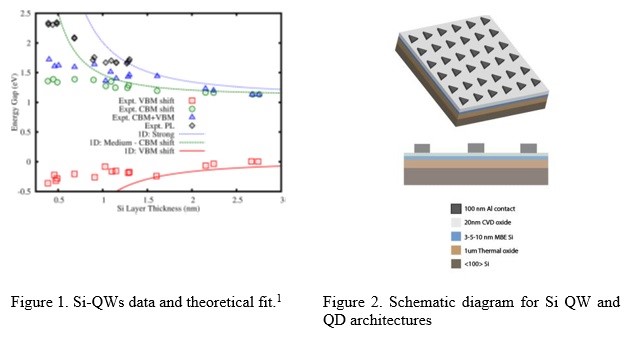Nanophotonic Enhancement of Silicon Quantum Dot Emission
Supervisor: Dr. Lyudmila Goncharova
Can extend to MSc?: Yes
Project Description (Abstract):
E. Johlin, L.V. Goncharova, P.J. Simpson
There is currently an effort to merge the electrical and optical properties of light emitting quantum structures, due to their potential application in photonic and optoelectronic devices. We have explored various approaches for improving the luminescence of Si quantum dots (QDs) produced by ion beam implantation or chemical vapor deposition. These quantum structures offer great advantages; the wavelength of the light emission is controlled by a dimensions of quantum confinement1, they are very stable compared to their analogs prepared by wet chemistry methods. Poor light emission of the Si quantum materials as well as the lack of understanding of the electrical transport mechanism hinders the development of a Si-based light source. This type of light source would facilitate the production of all Si-based optical and optoelectronic devices which would have improved efficiency and be compatible with existing manufacturing technology. However, there is first a need to increase the light emission of Si-QDs systems because at present the light emitted from these nanoparticles is too low in intensity to be used in practical applications. Fabrication of these quantum structures will be performed in the Tandetron and Nanofab facility at Western. While preliminary optical and electrical studies (figure 2) have been performed2, the low intensity of optical emission can be improved via nanophotonic structures optimized with machine learning algorithms developed by Professor Eric Johlin of the Department of Mechanical & Materials Engineering at Western. In addition to current-voltage measurements, these samples will be probed by complementary methods, ellipsometry and photoluminescence (PL) spectroscopy. The application of these new structures in tandem with optical and electrical measurements, can be used to both improve performance, as well as better understand the origins of the unique properties of these fabricated quantum structures.
- E.G. Barbagiovanni, D.J. Lockwood, P.J. Simpson, L.V. Goncharova, Quantum confinement in Si and Ge nanostructures, JAP, 111 (2012) 034307.
- N.M. Darukhanawalla, A. Abdelal, L.V. Goncharova, P.J. Simpson, Transport mechanisms in Si quantum structures, submitted to JAP.


